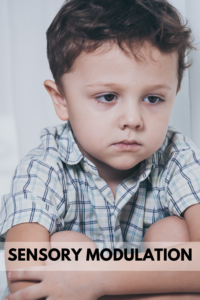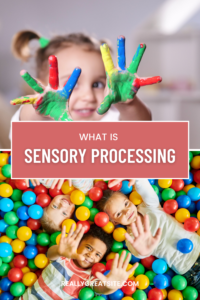
How sensory modulation can impact a child’s behavior and what to do about it
Are you curious about what sensory modulation really is? Maybe you are new to the world of sensory processing and are a new pediatric occupational therapist, a teacher, or a parent who has a child with some sensory processing challenges.
Well, you are in the right place. In this post, we will take a closer look at sensory modulation, and more specifically, how it could be impacting your child’s behavior.

Are you a parent of a child who is struggling with their behavior or is acting out? Maybe you are tired of endless battles or your child’s behavioral outbursts.
Do you know in your heart that your child is a sweet, loving child and their outward behavior is not a reflection of who they truly are?
Well, parents, trust your gut. There could be an explanation for this behavior, and this could be sensory modulation. Here, you will learn more about sensory modulation and how it could impact your child’s behavior.
Hi! My name is Marra, and I am a mama and a pediatric occupational therapist who has spent years working with children with a variety of sensory processing difficulties and supporting their families as they navigate the ups and downs of child development.
I can’t even count how many times I have worked with a parent of a child who was physically aggressive or had some other negative behavior.
The parents would tell me how they knew their child’s behavior was not an honest reflection of who they truly are.
I love their sigh of relief and the look of hope on the parent’s face as I began to describe how their child’s behavior may be related to sensory processing and sensory modulation.
I hope this post brings you some comfort as well or at leasts let you know you’re not alone.
This post is all about how sensory modulation may be impacting your child’s behavior.
what is sensory processing?
Before we take a closer look at sensory modulation, we first need to have a better understanding of sensory processing.
If you have read my other sensory-related posts, you know I have a brief overview of sensory processing in every post, so if you are a returning reader, go ahead and skip this section.
For those of you who are new, sensory processing is our ability to take in information from our environment, filter through the important information, try to understand it, and then choose an appropriate response.
We all process sensory information, and we this before we can really do anything else.
We have 8 sensory systems that receive sensory input all of the time, even when we are sleeping. We have the 5 more well-known senses: sight, sound, smell, taste, and touch.
In addition to these 5 senses, we also have 3 additional sensory systems that are less well-known: vestibular, proprioception, and interoception.
Our vestibular sensory system is our sense of movement and our response to gravity. It allows us to move around our environment without falling.
Our proprioceptive sensory system is our sense of deep pressure and body awareness. interoception is our sense of how our body is feeling.
Sensory processing involves making sense of all of the information we receive through all of our 8 sensory systems. If you would like to learn more about our 8 sensory systems, check out the pot linked below.

WHat is sensory Modulation?
Now that we. understand more about sensory processing, we can take a closer look at the sensory modulation definition.
Sensory modulation is the brain’s ability to regulate the sensory input received as well as decide what sensory input we need to pay attention to and what we can tune out.
Let me give an example to make it a bit clearer. Let’s say you are a parent, and right now you are reading this post, and your children are in the next room playing.
You can hear them talking and laughing, but you tune it out so that you can attend to this post. Their little giggles are unconsciously signaling to your brain that everything is fine and they don’t need you right now.
Now, let’s say you suddenly hear one of your children scream and start to cry. You will immediately and unconsciously switch your attention from this post to your child.
Your brain knows that your child’s crying is more important than this post. This happens automatically without you thinking about it.
Now, if you have difficulty with sensory modulation, you may not be able to attend to this post with the background noise of your children giggling, or it might take you more time to respond to your child’s cry.
Another common example of this is when a child does not respond to their name but does not have difficulty hearing.
They can hear you call their name and know they need to respond, but they are having difficulty modulating the information from their sensory environment and are unable to choose the appropriate response of shifting their attention to you.
A child who has sensory modulation dysfunction or sensory modulation disorder has difficulty modulating their sensory input. This can make simple tasks much more challenging for them and lead to negative behavior despite the best of intentions.

sensory over- responsiveness
Sensory over-responsiveness can absolutely impact a child’s behavior. Children who are over-responsive to sensory input have difficulty tuning out non-important sensory input.
In the example I gave above, having difficulty reading this post while your children are playing in the next room would be an example of sensory over-responsiveness.
We constantly have so much sensory input coming into the brain we have to be able to filter out what is important to pay attention to and what is not in order to function. We cannot pay attention to everything all of the time.
For children who are sensory over-responsive, it’s like everything is turned up. Imagine that you are on an important phone call, the TV in the room is on, you are trying to cook dinner, and you have 3 kids needing something from you all at once.
This overwhelmed feeling is what these children frequently feel throughout the day, even simpler tasks.
Children with sensory modulation dysfunction may have frequent tantrums, meltdowns, or heightened emotional responses to certain situations.
They may not have an outlet for these intense emotions and may become aggressive at times. They might avoid certain situations or sensory input, such as bright lights or loud noise.
sensory under-responsiveness
Sensory under-responsiveness occurs when an individual needs more sensory input in order to respond. For these individuals, it’s as if everything is turned down.
In our previous example, where you are reading this post with your children playing in the background, if you were under-responsive to sensory input it would take you longer to switch your attention from this post to your child when you heard them cry.
Another example of this is the child who takes longer to respond to their name. These children might be labeled as behavioral because they do not listen or are more aggressive than other children.
But remember, we have no control over how our brains modulate sensory input.
Why might a child who under-responds to sensory input be aggressive? Well, oftentimes, these children have decreased body awareness and difficulty grading pressure.
They might not think that they are using too much force when playing with a friend or toys. Because everything is turned down for them, they might need to interact with someone or something with more force in order to register the sensory input.
Also, children have less words to use to talk about how they are feeling, and ways to communicate their sensory needs to those around them. It’s so important to talk about emotions and honoring your own needs with all children.
How to help a child with sensory modulation dysfunction
So, how do you know if your child has sensory modulation dysfunction? Well, the easiest way to know for sure is to have your child evaluated by a pediatric occupational therapist.
OTs are the healthcare professionals who specialize in sensory processing and sensory modulation, really all things sensory.
We all vary on our sensory processing skills and sensory needs. That’s normal, and it’s what makes us unique. OT is a holistic, client-centered practice that focuses on a person’s participation in meaningful activities throughout the day.
During an OT initial screening or an evaluation, the OT will assess whether your child’s sensory processing skills impact participation in their daily activities such as school, play, mealtime, and bedtime among others.
They will closely examine any behavioral concerns you bring up to figure out why they are occurring and if they have anything to do with a sensory need that isn’t being met. I always say that an OT evaluation can only help.
If your child doesn’t need OT, then they won’t qualify for therapy services. If they do, then OT could significantly improve your child’s sensory processing skills and behavior. There’s no harm done in at least consulting with an OT.
If you would like to learn more about what to expect during a pediatric occupational therapy evaluation, check out the post below.

In the end, it is your choice of whether or not to pursue an occupational therapy evaluation or participate in occupational therapy services. You are the expert of your child, and only you know what is best for your child and your family. So, trust your gut!
Occupational therapy is a play-based therapy, and the children I worked with loved their therapy sessions.
Your child will participate in tons of movement sensory-based activities, and you, as the parent, will be provided with sensory modulation examples and sensory modulation activities to do with your child at home.
It is truly amazing to witness the transformation that can take place during occupational therapy sessions and the positive impact it has on that child’s and family’s life outside of therapy.
This post was all about how sensory modulation can impact a child’s behavior and what to do if you think your child might have sensory modulation difficulties.
